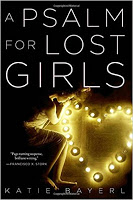I was reading a recent Goodreads Young Adult Newsletter when this cover caught my eye.

More specifically, a word caught my eye: GIRL. Katie Bayerl’s book, A PSALM FOR LOST GIRLS, looks great. It’s already on my to-read list. But that word…that word… It seems to be everywhere. I am not sure whether I am more intrigued or bothered when I see the word “girl” in a title. As a child, being called “girl” or “little girl” felt demeaning. Now, it’s part of the formula for high-concept, best-selling novels, many written by women, such as Gillian Flynn’s GONE GIRL, Paula Hawkins’ GIRL ON THE TRAIN, and Jessica Knoll’s LUCKIEST GIRL ALIVE. From Lena Dunham’s HBO series to Steig Larsson’s trend-starting GIRL WITH THE DRAGON TATTOO, the word is everywhere. And it’s plentiful in YA. Look…!






I am not the only one to be Googling this trend. Goodreads has compiled a list of nearly 800 books with “girl” in the title. National Book Award Finalist Emily St. John Mandel has researched the phenomenon. And USA Today is simply “girl tired.” As the mother of four sons, I sought comparable lists and articles for the word “boy” and came up largely empty handed (interestingly, the term “son” does yield some titles, though it does not ignite the same best-seller magic). As an English major, I looked for some connective thematic or story thread but the girls of this title trend run the gamut from gritty to destructive to romantic to empowered. I am annoyed, intrigued and, frankly, stumped.
In the interest of not putting any more “fake news” or “alternative facts” on the internet, I won’t editorialize some conclusion here. I’ll leave it to the linguists, etymologists and other social scientists to posit some reasons for this trend. But there is no denying that, right now, GIRL is a powerful word.


